A hero who has not become a hero. Tank KV at the beginning of the Great Patriotic
During the period of the so-called “perestroika” in the Soviet Union, a whole series of initiative groups and movements emerged, which began to engage in the return from oblivion of names and events that, it would seem, have been deleted forever stories. Of course, many of them could not circumvent such a topic as the Great Patriotic War.
So in the city on the Neva, then Leningrad, a campaign was launched in the local press to revive the “Defense of Leningrad” museum destroyed in 1949. As a result, a new museum called the Defense of Leningrad appeared in the city. Although the museum’s exposition occupied only one room and could not be compared with the one after the war, it seemed that things were getting off the ground. But it only seemed. The brutal political struggle for power, the collapse of the USSR, the beginning of the development of wild, merciless capitalism in Russia buried many good undertakings.
Until now, the museum "Defense of Leningrad" leads a miserable existence. The administration of the city with a different name does not painfully favor him with his attention. Many exhibits designed for him, are gone or still go to the side. Thus, the double-towered tank T-26 of model 1931 of the year raised from the bottom of the Neva, which was supposed to occupy an honorable place in the Museum of the Defense of Leningrad, suddenly appeared in Moscow, in the Museum of the Great Patriotic War on Poklonnaya Hill. But this is only a small fraction of those samples of military equipment, which are forever lost not only for the “Defense of Leningrad” museum, but also for the whole of Russia.
However, even in this state, the museum in the Salt City cannot complain about the absence of visitors - the interest in the Great Patriotic War among the current residents of the city and its guests is not weakening. On the stands of even such a meager exhibition of the museum you can see many interesting exhibits and documents. On one of them there is a photograph of five tankmen, located on the armor of a heavy tank KB-1. This is a tank crew commanded by senior lieutenant Zinovy Grigorievich Kolobanov. On August 19, 1941, his KB destroyed 22 enemy tanks in one battle. It would seem that here he is a hero! But Kolobanov for a number of reasons did not happen to become a Hero of the Soviet Union. They did not believe him, they considered him a dreamer. Few people knew about his feat in Leningrad itself, and even in present-day St. Petersburg, Kolobanov is not even remembered. Although even in foreign sources relating to tank battles on the Eastern Front in 1941-45. surname Kolobanova is mentioned quite often. Well, let’s try and we will tell about the famous battle that took place that day near the Troops, as well as tell readers about the fate of Zinoviy Kolobanov and the crew of his tank.
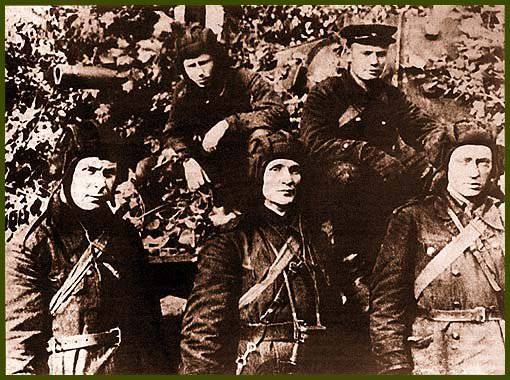
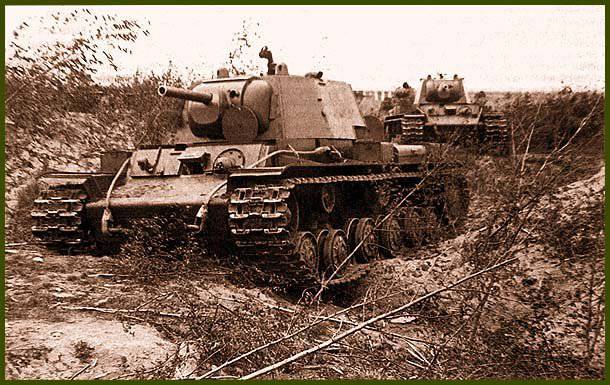
The events near Leningrad in August 1941 developed according to a very dramatic scenario. On the night of 7 on 8 August, the German Army Group North began an offensive on Leningrad. The 41 th motorized corps from the 4 th tank group and the 38 th army corps attacked the Ivanovo and Bolshoi Sabsk settlements in the direction of Kingisepp and Volosovo. Three days later, the enemy approached the Kingisepp-Leningrad highway. On August 13, German troops captured the Moloskovitsa station and cut the railway and the Kingisepp-Leningrad highway. They also managed to force the Luga River on the right flank of the front, and the city was between two fires. On August 14, all divisions of the 41 th motorized and 38 th army corps, having reached the operating room, rushed to Leningrad. 16 August were occupied by Narva and Kingisepp.
10 August 56 th motorized corps attacked the Soviet troops in the area of Luga. On the same day, heavy battles began in the Novgorod-Chudov direction. The next day, the Germans broke through to the Oredezh River. There is a threat over the left flank of the troops defending the Luga sector. August 13 The 34 and part of the forces of the 11 Army of the North-Western Front in the region of Staraya Russa and Lake Ilmen attacked the rear of parts of the 10 Army Corps. The German command hastily began to transfer the 56 th motorized corps, the SS Division “Dead head” and the 39 th motorized corps just transferred to Army Group North from Smolensk to this direction.
On August 16, parts of the 1 Army Corps took possession of the western part of Novgorod. There was a real threat of a breakthrough of the German troops to Leningrad.
On August 18, the commander of the 3 Tank Company of the 1 Tank Battalion of the 1 Red Banner Tank Division, Senior Lieutenant Zinoviy Kolobanov, was summoned to the division commander, General V.I. Baranov. The division headquarters was located in the basement of the cathedral, which is a landmark of Gatchina, which was then called Krasnogvardeisky. The task Kolobanov received personally from Baranov. Showing on the map three roads leading to Krasnogvardeisk from the direction of Luga, Volosovo and Kingisepp (through Tallinn highway - author's note), the division commander ordered:
- Shut them down and stand to the death!
The situation around Leningrad was such that the order of the division commander was literally taken by the tank company commander.
In the company Kolobanova was five tanks KV-1. Two tankloads of armor-piercing shells were loaded into each tank. High-explosive shells this time the crews took the minimum amount. The main thing was not to miss the German tanks.
On the same day, Kolobanov pushed his company towards the advancing enemy. The senior lieutenant directed two tanks — Lieutenant Sergeyev and Junior Lieutenant Evdokimenko — on the Luga road (the Kiev highway — author's note). Two more KBs under the command of Lieutenant Lastochkin and Junior Lieutenant Degtyar went to defend the road leading to Volosovo. The tank of the company commander himself was to be ambushed along the road connecting the Tallinn highway with the road to Marienburg - the northern outskirts of Krasnogvardeisk.
Kolobanov conducted a reconnaissance with the commanders of all the crews, indicated the positions of the firing positions and ordered to open two shelters for each vehicle - main and reserve, and then carefully disguise them. Communication with the company commander was to be maintained by the crews by radio.
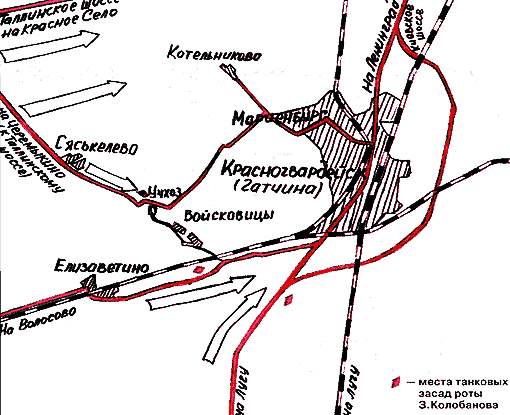
For his KB, Kolobanov defined the position in such a way that the longest, well-open section of the road was in the sector of fire. A little before reaching Uchkhoz's chicken farm, she turned almost 90 degrees and then went to Marienburg. It was crossed by another dirt road, on which, apparently, the locals after haymaking hay from the fields. Not cleaned stacks were visible all around, they were nearby and from the position chosen by Kolobanov. Extensive swamps stretched along both sides of the road leading to Marienburg. There was even a small lake with ducks swimming lightly on it.
Digging up a caponier for a tank like KB is very difficult. In addition, the ground got strong. Only in the evening we managed to hide the tank in the caponier, which was open to the very tower. A spare position was also equipped. After that, they carefully masked not only the tank itself, but even traces of its tracks.
The gunner-radio operator, senior sergeant Pavel Kiselkov, offered to go to an abandoned poultry farm and get a goose, since the people who worked on it, fearing the invasion of the invaders, left it, and the crew, exhausted by hard work, needed to reinforce their strength. Komroty agreed, ordering the radio operator to shoot the bird so that no one heard: in any case it was impossible to unmask its position. Kiselkov fulfilled the order exactly, goose plucked and cooked in a tank bucket. After dinner, Kolobanov ordered everyone to rest.
Closer to the night came the military guard. A young lieutenant reported to Kolobanov. He ordered the infantrymen to be placed behind the tank, to the side, so that if something happened they would not fall under gun fire. The positions of the military guard also had to be well disguised ...
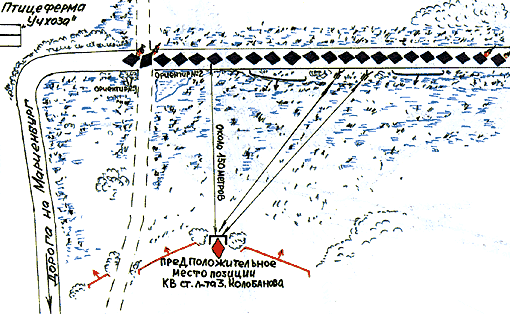
Zinoviy Grigorievich Kolobanov was born in 1913, in the village of Arefene, Vachevsky district of the Nizhny Novgorod province. After completing eight classes of secondary school, he studied at a technical school. In 1932, he was drafted into the Red Army in Komsomol recruitment. In 1936, he graduated with honors from the Oryol Armored School named after M.V. Frunze.
The war for 28-year-old senior lieutenant Kolobanova was not unusual. As part of the 20 heavy tank brigade as a company commander, he had the opportunity to participate in the 1939-1940 Soviet-Finnish war. The brigade in which he served first went to the Mannerheim Line, and his company was on the point of impact. It was then that Kolobanov first burned in the tank. In a battle at Lake Vuoksa, he again broke free with his company, and again had to flee the burning vehicle. The third time he was burning during a raid on Vyborg. On the night of 12 on 13 in March of 1940, a peace treaty was signed between the USSR and Finland. Upon learning of this, the soldiers of the two previously opposing armies rushed to meet each other for fraternization.
Unfortunately, this very “fraternization” cost the captain Kolobanov very dearly: he was lowered in rank and, having been deprived of all awards, was discharged into the reserve *. Since the beginning of the Great Patriotic War, Kolobanov was called up from the reserve to the 1-th tank division, created on the basis of the 20-th heavy tank brigade in which he fought during the war with the Finns. Since he already had combat experience, Kolobanov was given the rank of lieutenant and was appointed commander of a company of heavy tanks KV. True, they had to forget about previous awards, they had to start all over again, from scratch.
* - Kolobanov was not only deprived of his rank, awards and dismissed from the army, but also allegedly convicted. It is quite possible that this was the case, however, in what this conviction was expressed to the author is unknown.
Fighting vehicles tankers received at the Kirov plant. Here, at the factory, in a separate training tank battalion, tank crews were also formed. Each of them took part together with the workers in the assembly of his car. The run-in distance was from the Kirov factory to the Middle Slingshot, after which the cars went to the front.
* - These were shielded KV-1 tanks with installation of additional sheets of armor on the sides of the hull and turret. Moreover, the latter were not installed close to the main armor of the tower, but were bolted to metal bars, and those, in turn, were already welded directly to the armor of the tank. It has now become known that heavy tanks KV-1 with similar booking were produced only in July, 1941, and fought only on the North-West and Leningrad fronts. It is not hard to guess that the tank crews of the 1-th tank division got this particular modification of the KB.
In recent publications relating to the history of the creation of heavy tanks KB, it is stated that the Kirov and Izhora plants did not deal with their screening. There is no direct evidence that the Leningrad Metal Works was involved in this. However, according to some indirect documents, at this enterprise not only the assembly of buildings and towers, but also the screening of KV tanks could be carried out. It is quite possible that some of the towers and buildings that were shielded in this way came to the Kirov Plant from the Metal Works, since with the beginning of World War II it was also hooked up to an increase in the production of heavy KV tanks.
In the battle under Ivanovsky, Kolobanov managed to distinguish himself - his crew destroyed the enemy’s tank and weapons. That is why, knowing about the solid combat experience of Senior Lieutenant Kolobanov, General V.I. Baranov entrusted him with such a responsible task - with his company to block the path of German tanks to Krasnogvardeysk.
The 41-th motorized corps of Army Group North, which was advancing on Leningrad, bypassed Krasnogvardeisk. Only one of his divisions - the 8-I tank, was supposed to support the advance of the 50-second army corps and the SS-5 SS division from the Volosovo and Luga side to the Red Guard. The 6-I tank division in the previous battles suffered heavy losses and by the middle of August 1941 existed in fact only on paper, so it could not take part in the battles for Krasnogvardeysk. The 1 Panzer Division was advancing on Leningrad from the side of Torosovo, on Syaskelevo, and then on the northern edge of Krasnogvardeisk - Marienburg. In the event of a breakthrough to Marienburg, parts of this division could hit the rear of the Soviet troops, who defended the borders of the Krasnogvardeisky fortified area, and then, going through the old Gatchina parks to the Kiev highway, almost unhindered advance to Leningrad.
Early in the morning of August 19 1941, the crew of Kolobanov was awakened by a disgusting, intermittent roar of German diving bombers marching at high altitude towards Leningrad. After they had passed, silence and tranquility re-established under the Troops. The day began clear. The sun was rising higher.
At about ten, shots rang out to the left, from the side of the road going to Volosovo *. The senior lieutenant recognized the near "voice" of the KV tank weapon. A message arrived on the radio that one of the crews had fought with German tanks. And they were still all calm. Kolobanov summoned the commander of the military guard and ordered him that his infantrymen opened fire on the enemy only when the KV gun was spoken. Kolobanov and Usov set two guidelines for themselves: No. 1 - two birch trees at the end of the intersection and No. 2 - the intersection itself. Landmarks were chosen so as to destroy the enemy's head tanks right at the intersection, do not let the rest of the vehicles turn off the road leading to Marienburg.
* - Earlier it was erroneously stated that the battle began on the Luga road.
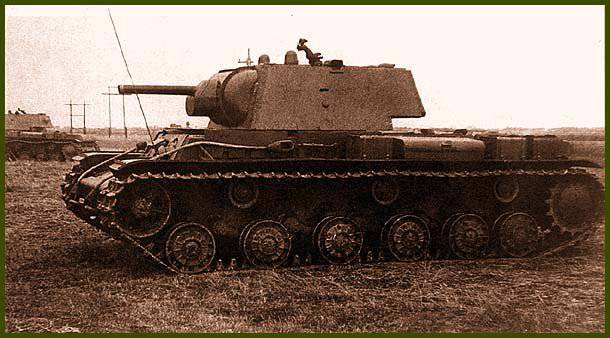
Only in the second hour of the day did enemy vehicles appear on the road.
- Get ready for battle! - quietly commanded Kolobanov.
Slamming the hatches, the tankers instantly froze in their places. Immediately the gun commander, senior sergeant Andrei Usov, reported that he saw three motorcycles with wheelchairs in the sight. The order of the commander immediately followed:
- Do not open fire! Skip scouting!
German motorcyclists turned left and rushed towards Marienburg, not noticing the disguised HF in ambush. Fulfilling the order Kolobanova, did not begin to open fire on reconnaissance and the infantrymen from the military guard.
Now all the attention of the crew was riveted on the tanks going on the road. Kolobanov ordered the radio operator to report to the battalion commander, Captain IB Shpiller about the approach of the German tank column, and again turned his attention towards the road, which the tanks painted in dark gray crawled onto one by one. They walked at reduced distances, substituting their left sides almost strictly at right angles to the KB gun, thus representing ideal targets. The hatches were open, part of the Germans sat on the armor. The crew even distinguished their faces, since the distance between the KB and the enemy column was small - only about one hundred and fifty meters.
At this time, the commander Shpiller came in contact with the company commander on the radio. He sternly asked:
- Kolobanov, why are the Germans missing ?!
Spiller already knew about the morning battle on the Lugovsky and Volosovsky directions and about advancing German tanks towards Kolobanov's position, and he could not but be disturbed by the fairly prolonged silence of the KB commander of a tank company.
There was no time for the battalion commander to answer: the lead tank slowly entered the intersection and came close to two birch trees - reference point No. 1, planned by the tank crews before the battle. Kolobanov was immediately informed about the number of tanks in the convoy. They were 22. And when the seconds of the movement remained until the benchmark, the commander realized that he could no longer delay, and ordered Usov to open fire ...
Senior Sergeant Usov by the beginning of World War II was already an experienced soldier. Called to the Red Army in 1938, he participated in the “liberation” campaign in Western Belarus as assistant platoon commander of one of the artillery regiments, during the Soviet-Finnish war he fought on the Karelian Isthmus. After graduating from a special school of commanders of heavy tank guns, he became a tanker * ...
* - In separate editions devoted to the Great Patriotic War and the defense of Leningrad, at the mention of this fight, sometimes only the name of the tank commander, Senior Sergeant Usov, is mentioned, and the commander of the tank Kolobanov is not mentioned at all.
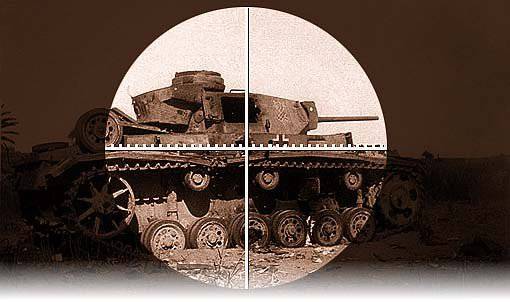
The lead tank caught fire from the first shot. It was destroyed, not even having time to completely pass the intersection. The second shot, right at the intersection, was defeated by the second tank. Cork formed. The column shrank like a spring, and now the intervals between the remaining tanks have become minimal. Kolobanov ordered to transfer the fire to the tail of the column in order to finally lock it on the road.
But this time, Usov failed to hit the closing tank from the first shot - the projectile did not reach the target. The senior sergeant corrected the scope and fired four more shots, destroying the last two in the tank column. The enemy was trapped.
At first, the Germans could not determine where the shooting was going on and opened fire with their guns at haybuns, which immediately caught fire. But soon they came to their senses and were able to detect an ambush. A single-tank tank duel against eighteen German tanks began. A whole hail of armor-piercing shells hit Kolobanov’s car. One by one they plowed through the 25-mm armor of additional screens mounted on the HF turret. There is no trace left of disguise. Tankers were suffocating from the powder gases and stalled from the numerous blows of blanks on the tank's armor. Charging, he is also a junior driver mechanic, Red Army soldier Nikolai Rodenkov worked at a furious pace, driving a shell after a shell into the breech of a cannon. Usov, not looking up from the sight, continued to fire at the enemy convoy.
Meanwhile, the commanders of other vehicles holding the defense on three more roads, reported on the radio on the situation in their defense sectors. From these reports Kolobanov understood that fierce battles were taking place in other directions.
The Germans, realizing that they had fallen into a trap, tried to maneuver, but the KB shells hit the tanks one by one. But the numerous direct hits of enemy shells did not cause much harm to the Soviet machine. The apparent superiority of KB over German tanks in terms of fire strength and thickness of armor had an effect.
* - Reservations for frontal and side plates of the hull and turret of a Soviet heavy tank KV-1 reached 75 mm, and for shielded machines 100 mm. By booking the KV-1 hull of the 1941 model of the year, it was inferior only to the English Churchill I, therefore the Kolobanov tank's armor could not penetrate the short-barreled 75-mm and 50-mm guns of German tanks (not to mention the 20-mm and 37-mm guns) . It should be recalled that the 50-mm gun KwK 38 medium tank Pz. Ill punched 100 mm with an armor-piercing projectile 45 mm of armor from a distance of 72 and 75 mm with a subcaliber. German medium artillery support tank Pz. IV, armed with an 37-mm KwK 100 cannon, with 31 meters, an armor-piercing projectile punched through even thinner armor — only 76 mm. X-NUMX-mm F-32 cannon of the KV-1 tank, punched 500 mm from the 60 meters distance, mm X-NUMX meters - 1000-mm armor, confidently hitting tanks pz.ivh Pz.lll not to mention light Pz. II and 52 (t). In this case, the battle was fought at a distance of about 38 meters ...
The infantry units following the column came to the aid of the German tank crews. Under the cover of fire from tank guns, for more effective shooting at KB, the Germans rolled anti-tank guns onto the road.
Kolobanov noticed the preparations of the enemy and ordered Usov to hit high-explosive fragmentation projectile on anti-tank guns. With the German infantry, the combat guard stationed behind the KB was engaged.
Usov managed to destroy one VET together with the calculation, but the second managed to make several shots. One of them broke the panoramic periscope, from which Kolobanov watched the battlefield, and the other, striking the tower, jammed it. Usov was able to break this gun, but KB lost the ability to maneuver the fire. Large dovoroty guns to the right and left could now be done only by turning the entire hull of the tank. Essentially, KB has become a self-propelled artillery installation.
Nikolai Kiselkov climbed onto the armor and installed a spare periscope instead of the damaged one.
* - Probably, the German disc, knocking down an armored cap, broke the upper part of the periscope. Usually, observation devices are changed by the crew from inside the tank, but the situation did not allow Kolobanov to replace it with his own forces alone. Therefore, the less-busy radioman gunner responded in time and replaced the damaged element of the periscope. In addition, the hatch of the driver, who was on the roof of the KB case, helped him to do this risky operation quickly enough.
Kolobanov ordered the foreman mechanic, Senior Nikolai Nikiforov, to withdraw the tank from the caponier and take a spare firing position. In the eyes of the Germans, the tank backed out of his hiding place, drove off to the side, stood in the bushes and re-opened fire on the column. Now I had to work hard to the driver. Fulfilling Usov's orders, he turned the KB in the right direction.
Finally, the last 22 tank was destroyed.
During the battle, and it lasted more than an hour, senior sergeant A. Usov fired 98 shells on the tanks and anti-tank weapons of the enemy, all of which were armored through. (Note - The KV-1 tank ammunition of the first half of the 1941 model was 114 shells.) Further observation showed that several German tanks were able to break through to the “Voyskovitsy” state farm from the south.
In contact with the crew out combat. In a loud voice, Shpiller asked:
- Kolobanov, how are you? Are they burning?
- Well burn, Comrade Kombat!
The senior lieutenant reported that the crew crushed an enemy tank column of 22 combat vehicles. His crew is not in a position to keep his position further, as ammunition runs out, there are no armor-piercing shells at all, and the tank itself was seriously damaged.
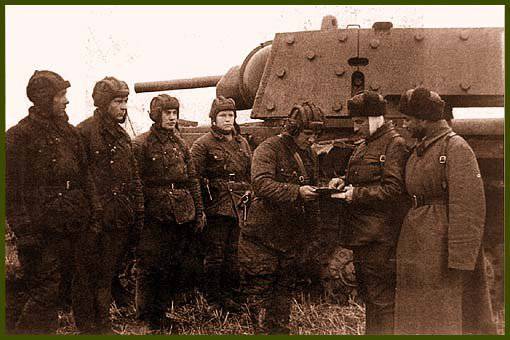
Spiller thanked the crew for successfully completing the combat mission and said that tanks of Lieutenant Lastochkin and Junior Lieutenant Degtyarya were already on the way to the “Voyskovitsy” state farm. Kolobanov ordered Nikiforov to join them. Having planted the infantrymen who remained from the military escort (many of them were wounded), the KB with a landing force on the armor rushed for a breakthrough. The Germans did not get involved in a battle with the Russian tank, and the KB freely reached the outskirts of the state farm. Here Kolobanov met with the commanders of the approached tanks.
From them, he learned that in the battle on the Luga road, the crew of Lieutenant Fyodor Sergeyev destroyed eight German tanks, the crew of Junior Lieutenant Maxim Evdokimenko - five. The junior lieutenant was killed in this battle, three members of his crew were injured. Survived only mechanic driver Sidikov. The fifth German tank, destroyed by the crew in this battle, was precisely the driver’s account: Sidikov rammed him. The KB itself was thus disabled. The tanks of Junior Lieutenant Degtyar and Lieutenant Lastochkina that day burned four enemy tanks each.
Total 19 August 1941 year tank company was destroyed 43 enemy tank.
For this battle, the commander of the 3 tank company, Senior Lieutenant Z.G. Kolobanov was awarded the Order of the Fighting Red Banner, and the commander of his tank gun was Sergeant AM Usov - the Order of Lenin ...
Half an hour later, the State Farm "Troops" was cleared from the enemy. Having again reported Shpiller the situation, Kolobanov received an order to move the whole company to the rear to replenish ammunition and repair. When, after the battle, the crew began to inspect their car, X-NUMX counted 156 marks from armor-piercing shells on the armor.
* - In various sources, the number of dents on the armor of a Kolobanov tank is different: either 135, or 147, or 156
As soon as the position under the Troops stabilized, Spiller brought the crew of Kolobanov with the German tanks of the front-line cameraman to the battlefield, who, raising his camera, captured the panorama of the burning column.
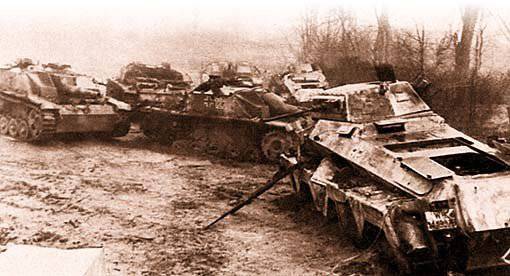
Thus, the skillful actions of tankers of the 1 th Red Banner Tank Division at the boundaries of the Red Guard fortified area subsequently helped stabilize the front at Pulkovo Heights and keep the enemy out of Leningrad.
Repair of the tank dragged on for almost a month. On the night of September 21 in the cemetery of the town of Pushkin, where the tanks were fueled with fuel and ammunition, a German shell exploded next to KB Kolobanov. At this time, the comrades had just got out of the tank, and they threw it to the ground with monstrous force. Senior Lieutenant was sent to the hospital in an unconscious state. In the case history of Zinovy Kolobanov, stored in the Military Medical Archives, it appears: “Fragmentation of the head and spine. Contusion of the brain and spinal cord.
In 1942, in serious condition, he was transported across Lake Ladoga to the mainland. Then there were months of immobilized lying in hospitals, prolonged unconsciousness, and only then an extremely slow return to life.
By the way, in the hospital, when the wounded showed one of the editions of the “Front newsreel,” Kolobanov saw his work - the enemy's broken tank column.
Despite the serious injury and contusion, Kolobanov again asked to be commissioned. The stick, on which he leaned while walking, had to be thrown out. And at the end of 1944, Kolobanov is again at the front, commanding the SU-76 division. For battles on the Magnushevsky bridgehead, he received the Order of the Red Star, and for the Berlin operation - the second order of the Battle Red Banner.
After the war, serving in one of the armies in Germany, he took a battalion of heavy tanks EC-2. In a very short time, his battalion becomes the best in the army. The commander awarded Zinoviy Kolobanov with a personalized hunting rifle.
He managed to find his wife and young son. Kolobanov knew nothing about the whole war, he broke up with his pregnant wife on the first day of the war. But Zinovy Grigorievich and Alexandra Grigorievna found each other: one of the radio programs helped to find relatives and friends who were lost during the war.
But it seemed to fate that she had not fully experienced this man. A soldier deserted from the battalion, he subsequently showed up in the British occupation zone. Above the battalion threatened military tribunal. Commander Kolobanova Spas: announcing incomplete official compliance, he transferred him to the Belarusian Military District. Everything that happened did not pass for the officer without a trace: the consequences of a concussion are exacerbated. By disability, he is dismissed.
On this troubles tanker is not over. For a long time Kolobanov was reluctant to believe when he talked about the famous battle and the number of tanks destroyed by his crew. There were cases when from the audience, hearing about the number of shot down tanks, came an ironic laugh: “They say, lie veteran, but know the measure!”
Once Kolobanov asked for the floor at the military-historical conference held in the House of Officers in Minsk. He spoke about the role of tank divisions in a defensive battle, referred to his own example and spoke about the battle under the Army-troops. One of the speakers, slyly grinning, said that this was not and could not be! Then, barely restraining his excitement, Zinovy Grigorievich handed over to the presidium a yellowed front-page newspaper. The general in charge of the conference quickly looked through the text, called the speaker to him and ordered:
- Read aloud so that the whole hall can hear!
In the 1995 year, Zinovy G. Kolobanov, never becoming a Hero of the Soviet Union, died.
Happier was the fate of the gun commander Andrei Mikhailovich Usov. He went through the entire Great Patriotic War, from Leningrad to Berlin, ending it in the rank of lieutenant. He was awarded the Order of Lenin, World War II degree, the Red Star and medals. After the war, he returned to his hometown Tolochin, which is located in the Vitebsk region of Belarus, where he worked until he retired. However, Alexander Mikhailovich will not be able to tell about that amazing fight again - he, like Zinoviy Grigorievich Kolobanov, is no longer alive.
Soon after the commander was wounded, a gunner-radio operator, senior sergeant Pavel Ivanovich Kiselkov, was killed in a battle on the Nevsky “patch”. The junior mechanic-driver of the Red Army Nikolai Feoktisovich Rodenkov did not return from the war either.
The former senior tank driver Nikolai Ivanovich Nikiforov, like Usov, went through the whole war to the end, and then stayed to serve in the tank forces of the Soviet Army. After the transfer to the reserve he lived in the city of Lomonosov. In 1974, he passed away from severe lung disease.
The frames of the “Frontline Newsreel” were also lost, where the German tanks destroyed by Kolobanov were captured.
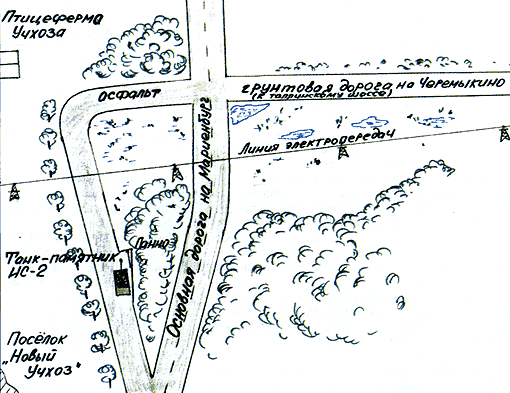
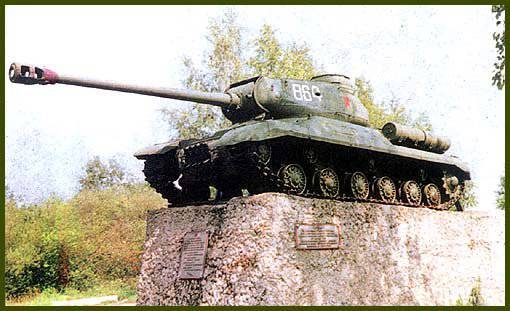
On the site of the battle of Kolobanov’s crew with a German tank column, a monument was erected. On the gray, similar to a huge brick pedestal, there is a heavy tank EC-2, the last post-war modernization. Apparently, the authors of the monument did not manage to find the KV-1 *. However, even then, and even more so now, it was almost impossible to find tanks of this type. Therefore, put on the pedestal "IS". After all, he is also Kirovsky (albeit from Chelyabinsk), and the appearance, at least by the chassis, is similar to HF. Memorial plaques attached to the pedestal remind of what happened here in August 1941 of the year.
* - In St. Petersburg and the Leningrad Region, KB tanks can be seen in two places: the KV-1, but already the release of the Chelyabinsk Kirov Plant can be seen in the suburb of St. Petersburg - the village of Ropsha. The tank has a battle view, numerous markings of German pigs remain on its armor. Another KB tank, but only of a later modification, the KV-85, is located in St. Petersburg on Stachek Avenue, in Avtovo.
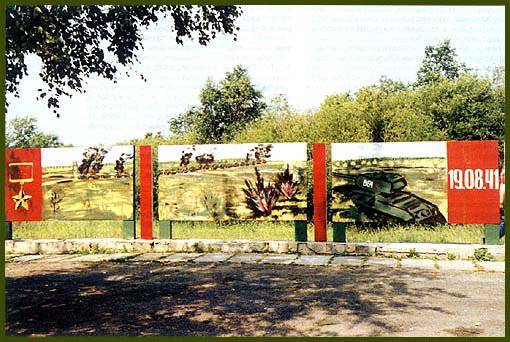
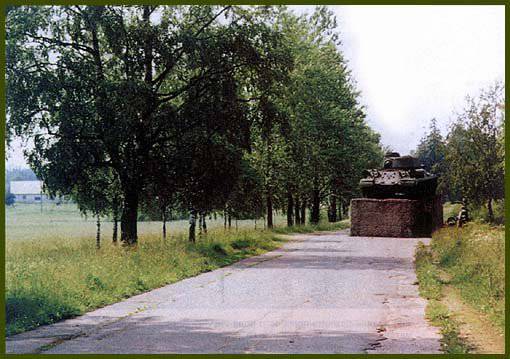
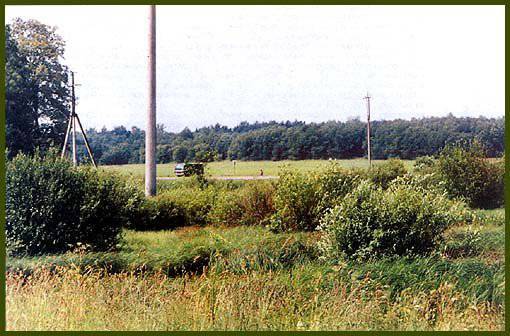
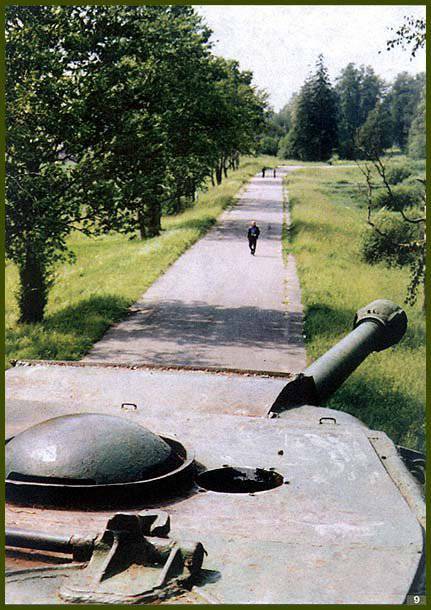
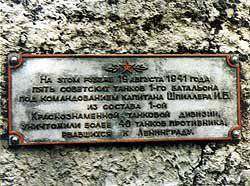
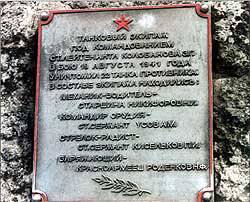
Despite the fact that the front part of the "brick" is raised, the view of the tank is not the most formidable. It's all about his 122-mm gun, which is at the minimum angle of inclination.
Next to the memorial tank there is a coarsely painted “heroic panel”, which depicts a tank, vaguely reminiscent of a KB, with the 864 No. and a red star on the tower, striking enemy tanks from its gun. Who served in the army should remember this kind of drawings, painted with oil paint on rusty sheets of iron, flaunted on the territory of literally every military unit. A star of the Hero of the Soviet Union is drawn next to the picture of the battle, although none of Kolobanov’s crew received this high award.
Part of the road, on which the German tanks were advancing, did not wait for asphalt: it was filled with rubble. Asphalt is laid only on its small segment - on the way from the monument to the crossroads. That second, inconspicuous, road that crossed the main road became a solid asphalt road. Despite the fact that part of the swamps surrounding the road is drained, there are still enough ditches and reservoirs covered with mud and reeds.
The farm of Uchkhoz has also been preserved, but the two birch trees that served as a guide for tankers have not survived. Apparently, the construction of a new road and a power line did not spare them.
At the moment, the monument tank has a very shabby look. The tank itself needs new painting, the additional fuel tanks have rusted so much that big holes are visible in them. The grids of the engine compartment are torn out almost with “meat”. At the pedestal - a miserable likeness of a wreath. Behind the monument one can see the squalid block houses of the village of New Uchkhoz.
Local residents, who cherish the memory of the Great Patriotic War, complain that there is always a lot of garbage around the monument, as someone literally broke and crushed all the flowers laid the day before at the foot of the podium on the day after 9 in May. This brings to mind another tank monument, the thirty-four, exploded on the Nevsky Piglet by some scumbags on the night of 21 on 22 of June 2002 of the year. This is how some of the current "grateful" descendants honor the memory of the defenders of Leningrad.
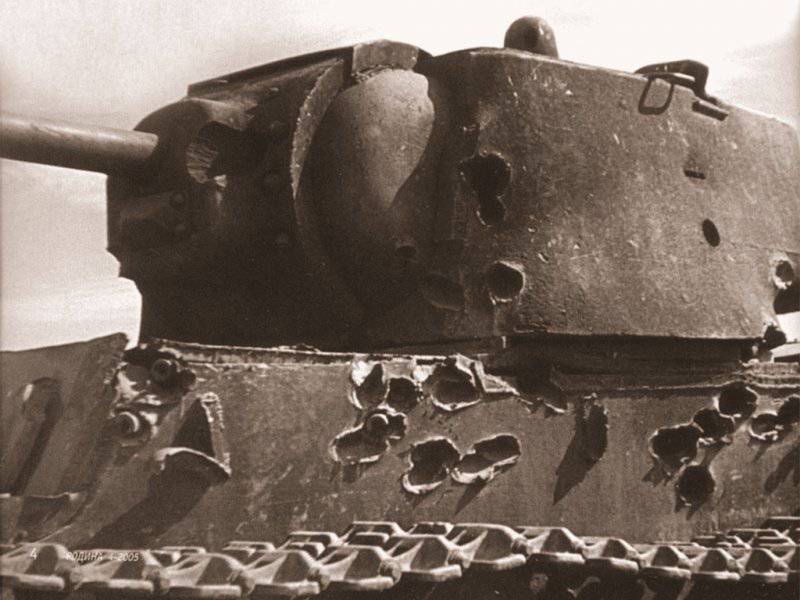
Information